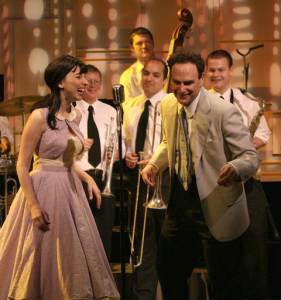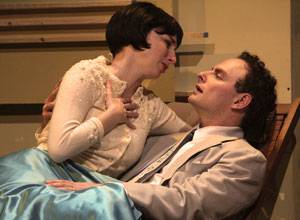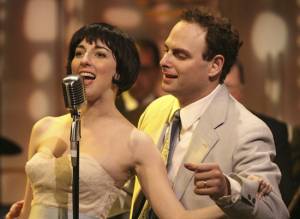
World Premiere musicals are pretty much a monthly event in Los Angeles, and though many of them become audience and critical favorites, even the best of them tend to disappear after their initial engagements, the business of musical theater being what it is. Thus, one can suppose that when Jake Broder and Vanessa Claire Smith debuted Louis And Keely Live At The Sahara at Sacred Fools Theater back on May 30 of last year, the duo had reason to expect that their self-penned tribute to Louis Prima and Keely Smith would close as scheduled on June 29–and that would be the end of it.
Such was not the case. The show was not only extended, it reopened at the Matrix later that year and won the Ovation Award for Best Intimate Theatre Musical, four L.A. Drama Critics Circle Awards including Best Production, and two L.A. Weekly awards including Musical Of The Year.
Not content to rest on their laurels, Broder and Smith rewrote huge chunks of their book, and with a new director (Academy Award winner Taylor Hackford doing terrific work here), a bigger budget, a new design team, and Frank Sinatra as a major supporting character, Louis And Keely Live At The Sahara reopened at the Geffen Playhouse a year after its first performance at Sacred Fools. Rave reviews kept on coming, and so did the extensions, and just a week or so ago, the bigger, better Louis And Keely scored five Ovation nominations. How about that for a success story!
I loved Louis And Keely when I saw it in its earlier incarnation last year, and there’s even more reason to love it now.
The show starts off pretty much as did the original version, with a comatose Prima lying in a hospital bed center stage. (Prima’s three-year-long coma ended only with his death in 1978.) When Louis’s pulse begins racing, a bedside nurse looking suspiciously like Keely Smith tells the attending physician that the same phenomenon has been occurring every night … at midnight. Suddenly, the fingers on Louis’ left hand begin to snap, a drum begins beating along with the finger snaps, musicians take their places at the upstage bandstand, and before you know it, the hospital bed is gone and Louis Prima is back in action again.
“I’m Louis, from N’Orleans,” he tells us in one of his onstage monologs, and in case we’re thinking of Louis Armstrong, he adds, “No, the other one.” It’s 1949, and Louis’s been a successful singer-bandleader for more than two decades, but the times they are a changing, and Louis’s in need of a new sound, more jitterbug and less foxtrot. Before you know it, teenage Dorothy Keely has arrived to audition, still in her red swimsuit from the beach at Virginia Beach, and Louis’ prayers are answered.
The raven-haired songstress wins Louis over with her rendition of “Embraceable You,” and before long is rechristened Keely Smith. “She was the sound that was going to save the band,” Louis announces to us with pride, though he informs the headstrong sixteen-year-old, “This is my show, and you do what I tell you to do.” Louis and Keely’s life together was clearly going to be quite a roller coaster ride.
Louis And Keely Live At The Sahara moves backwards and forwards in time, as Louis drifts in and out of his memories, often addressing the audience directly, as when he tells us about Keely, “I needed her cause she was my window to you.” Keely soon becomes so important to Louis that he’s willing to share billing with her, and “Louis Prima never shares billing with anyone.”
Louis And Keely Live At The Sahara makes the audience flies on the wall to Louis and Keely’s on-and-offstage relationship. At one point, Keely tells the womanizing Louis, “How come you never look at me in real life like you look at me on stage?” Later, when Louis pops the “Will you marry me?” question, head-over-heels Keely wastes hardly a second in telling him a big “Yes!” Soon, the papers are calling Keely a “new overnight sensation,” and as her own popularity begins to overshadow Louis’, cracks appear in their relationship. Still, when Louis tries to lay down the law (“I make the jokes. You play it cool. You know whose show it is.”), Keely replies dryly, “Well, Downbeat says it’s mine.”
In its original incarnation, it was Louis and Keely and the band, and that seemed quite enough for the more intimate venue. At the larger Audrey Skirball Kenis Theater, the two stars are joined by a quartet of supporting actors playing various characters in Louis and Keely’s life—Louis’ older brother Leon, Keely’s mother, club owners and patrons, assorted women in Louis’s life, and most significantly, Frank Sinatra.
The addition of Sinatra as a character brings new dimensions to the Louis-Keely story and new scenes to Louis And Keely Live At The Sahara. It’s fascinating to watch the musical superstar offer Keely her own solo LP with a casual touch of his hand under the hem of her dress, all the while proclaiming that there’ll be “no strings.” It’s fun also to see how Sinatra manages to make Louis think that Keely’s solo album is Louis’ own idea. As Sinatra’s hands-on participation in Keely’s career makes her star burn brighter, Louis’ own star dims, and what’s a macho Italian to do but seek out other women who’ll make him feel like a man again?
A woman scorned finds her own ways to get back at the man who’s been unfaithful to her, and Keely is no exception. The original production had her getting her revenge on philandering Louis with baby-faced band member Sam. At the Geffen, it’s the Kid From Hoboken who serves the same purpose (as apparently he did in real life), piquing audience interest because the man is, after all, Ol’ Blue Eyes himself.
Performing almost two dozen of Louis and Keely’s many hits, Broder and Smith disappear into the skins of the legendary duo. “Them There Eyes,” “That Old Black Magic,” “Embraceable You,” and “Just A Gigolo” are just a handful of the songs that make Louis And Keely Live At The Sahara the swingin’est show in town. The original ninety-minute production is now an hour and three quarters, and new songs have been added, including “What Is This Thing Called Love” and “I Wish You Love.”
Broder gets the biggest workout, the London-trained Broadway veteran’s performance a whirlwind of manic energy, a one-of-a-kind performer in a one-of-a-kind role. Smith plays the more low-key part, but Keely’s deadpan stage persona masked a fiery (and feisty) gal who could give as good as she got. Both Broder and Smith are sensational singers, and trained actors who fully embody the celebrated pair. The revised script give both even more chances to dazzle as actors, particularly in dramatic scenes, as Louis and Keely’s love starts to go on the rocks. If Broder’s role tended to overshadow Smith’s in the original version, it’s less true now, as script revisions allow Smith to really dig deep into the pain of discovering her husband’s betrayal. (Both have been Ovation nominated for the second year in a row in the lead actor/actress categories, and the show itself has been nominated for Best Large Theater Musical.)
Recent Geffen cast addition Curt Bonnem (Doctor, Club Owner, Leon Prima, Frank Sinatra) has been on a role since last year’s Lovelace A Rock Opera, and he shines once again in his quartet of roles, particularly as he disappears into Sinatra’s sexy skin and crooner voice. Michael Lanahan and Erin Matthews both do fine work in a variety of roles, and in Matthews’ case in at least half a dozen different wigs. Crystal Keith (Keely understudy) completes the cast as a recording studio singer and “dancing lady.”
Now as before, the onstage band is a huge part of Louis And Keely Live At The Sahara’s appeal, and a better, more swinging bunch of musicians you won’t find anywhere in town. Trumpeter Paul Litteral (from the original production) now shares musical direction credit with Broder, leading the show’s sensational Vegas-ready band, completed by Colin Kupka, Richard Levinson, Nate Light, Jeff Markgraf, Michael L. Solomon, Dan Sawyer, and Brian Wallis. (All but Sawyer are returning from the production I saw at the Matrix.) The show also has a choreographer now, Vernon Bagneris, for several brief dance sequences.
The design team is all new here, giving the Geffen production a classier, flashier look. Joel Daavid’s terrific set design keeps the band center stage, with smaller side stages used for many of the dramatic sequences. Daavid’s projection design transports us from the French Quarter of New Orleans to the Las Vegas desert, and helps to situate Louis And Keely in a particular time and space in a way that the original production did not. Anne Militello’s lighting is Vegas flashy and desert sun dazzling, and dramatic lighting switches take us from Louis’ comatose mind to actual events in his life. Lindsay Jones’ sound design expertly mixes voices and instruments in the show’s many musical numbers. (Militello and Jones have both been nominated for Ovation awards.)
Louis And Keely Live At The Sahara in now in its final extension at the Geffen, set to close on November 8. Only days remain to catch the most buzzed-about show in town. Even more than before, Louis And Keely Live At The Sahara is not to be missed.
Geffen Playhouse, 10886 Le Conte Ave., Westwood.
www.geffenplayhouse.com
–Steven Stanley
October 27, 2009
Photos: Michael Lamont





 Since 2007, Steven Stanley's StageSceneLA.com has spotlighted the best in Southern California theater via reviews, interviews, and its annual StageSceneLA Scenies.
Since 2007, Steven Stanley's StageSceneLA.com has spotlighted the best in Southern California theater via reviews, interviews, and its annual StageSceneLA Scenies.







 COPYRIGHT 2024 STEVEN STANLEY :: DESIGN BY
COPYRIGHT 2024 STEVEN STANLEY :: DESIGN BY